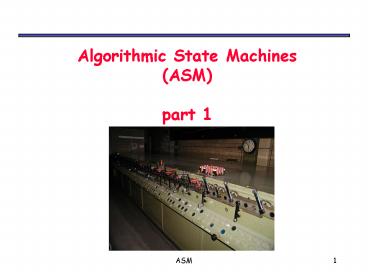Algorithmic State Machines (ASM) part 1 - PowerPoint PPT Presentation
Title: Algorithmic State Machines (ASM) part 1
1
Algorithmic State Machines(ASM)part 1
2
Algorithmic State Machine (ASM)?
- Our design methodologies do not scale well to
real-world problems. Take this
3
Algorithmic State Machine (ASM)?
- Procedure for implementing a problem with a given
piece of equipment. - Define digital algorithmic solutions for
hardware. - Resembles a conventional flow chart but
interpreted differently - ASM described the sequence as well as the timing
of events. - Adapted to specify the control sequence and data
processing operations.
4
Control and datapath
- A digital system can be split into two
components - Datapath unit Manipulates data according to the
system requirements. - Control unit Generates the signals for
sequencing the operations in the data processor. - Figure 8.2 Control and datapath interaction
5
State box
- Figure 8.3 ASM chart state box
6
Decision box
- Figure 8.4 ASM chart decision box
7
Conditional box
8
ASM block
- One entrance path
- Any number of exit paths
- Describes the state of the systems during one
clock-pulse interval. - The operations within the state and the
conditional boxes are executed with a common
clock pulse while the system is in state S_0.
9
ASM chart State diagram
10
Timing
- All the following operations occur
simultaneously - A ? A1
- If E 1 then R ? 0
- Depending on E and F, the state is changed to
S_1, S_2 or S_3.
11
Design problem
- Design a digital system with two flip-flops, E
and F, and one 4-bit binary counter, A. The
individual flip-flops of A are denoted by
A4,A3,A2, and A1, with A4 holding the MSB. A
start signal S initiates system operation by
clearing the counter A and the flip-flop F. The
counter is then incremented by 1 starting from
the next clock pulse and continues to increment
until the operations stop. Counter bits A3 and A4
determine the sequence of operations - If A3 0, E is cleared to 0 and the count
continues. - If A3 1, E is set to 1 then if A4 0, the
count continues, but if A4 1, F is set to 1
on the next clock pulse and the system stops
counting.
12
ASM Chart
- Design a digital system with two flip-flops, E
and F, and one 4-bit binary counter, A. The
individual flip-flops of A are denoted by
A4,A3,A2, and A1, with A4 holding the MSB. A
start signal S initiates system operation by
clearing the counter A and the flip-flop F. The
counter is then incremented by 1 starting from
the next clock pulse and continues to increment
until the operations stop. Counter bits A3 and A4
determine the sequence of operations - If A3 0, E is cleared to 0 and the count
continues. - If A3 1, E is set to 1 then if A4 0, the
count continues, but if A4 1, F is set to 1
on the next clock pulse and the system stops
counting.
13
(No Transcript)
14
(No Transcript)
15
The datapath
16
State diagram for control
17
(No Transcript)
18
(No Transcript)
19
(No Transcript)
20
Algorithmic State Machines(ASM)part 2
21
(No Transcript)
22
Datapath for binary multiplier
- Sum only two binary numbers accumulating the
partial sums in Register Q. - Instead of shifting the multiplicand to the left,
shift the product to the right
23
ASM for binary multiplier
- P the number of bits in the registers
24
(No Transcript)
25
(No Transcript)
26
(No Transcript)
27
(No Transcript)
28
(No Transcript)
29
(No Transcript)
30
(No Transcript)
31
(No Transcript)
32
(No Transcript)
33
(No Transcript)
34
Control Logic
- Signals to be generated
- T0-T3
- L (The Load signal for Register A, that allows
the loading of the output of the binary adder.
35
Control Circuit implemented with D flip-flops
Dec
36
(No Transcript)
37
(No Transcript)
38
ASM with four control inputs
- Operations are left blank.
- We are interested in the design of the control
part only. - Four control inputs w, x, y, z
- Four states T0-T3 needs 2 flip-flops.
39
Using MUXes to implement the control logic
- Two D flip-flops encode the state.
- The state is decoded into state signals T0-T3 by
a decoder. - The current state multiplexes the next state.
- Challenge how to set the inputs of the MUXes?
40
(No Transcript)
41
The complete circuit
42
Count-of-Ones
- The system consists of two registers R1 and R2
and a flip-flop E. - The system counts the number of 1s in the number
loaded into R1 and set R2 to that number. - Shift one bit from R1 into E.
- If E 1 then R2
- If Z 1 (that is R1 0) then stop.
- R2 is initialized to all 1s. Why?
43
Datapath for Count-of-Ones
44
(No Transcript)
45
Control logic for Count-of-Ones































